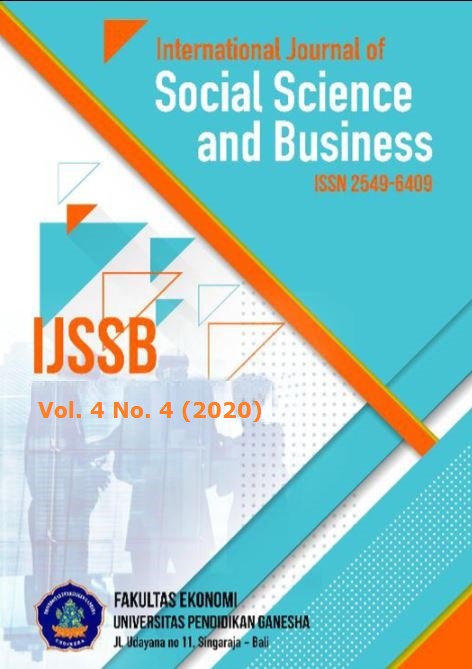Analysis of Sharia Banking Efficiency in Industry Revolution 4.0 Era
DOI:
https://doi.org/10.23887/ijssb.v4i4.29537Keywords:
Sharia Banking, Efficiency, Data Envelopment Analysis, 4.0 EraAbstract
This research aimed to analyze the efficiency of Sharia Banking in Indonesia for the period of 2013-201, the era of industry revolution 4.0. The research method used Data Envelopment Analysis while the data was taken from the annual report of Sharia Banking Statistic issued by Indonesia Financial Services Authority for the intended years. The input variables were the third-party fund, labor cost, and other cost while the output variables were total financings and operating income. Both with CRS and VRS model input approach, Sharia Banking in Indonesia generally already had high-efficiency value either based on years or banks. The banks who had not been in high-efficiency criteria were highly recommended learning from the benchmark banks. The result showed in general the use of technology and the internet by Sharia Banking was already appropriate, which caused their operations running efficiently.
References
Abidin, Z., Endri, & Nirmalawati, D. (2008). Kinerja Keuangan dan Efisiensi Perbankan: Pendekatan CAMEL, DEA dan SFA. ABFI Institute Perbanas.
Ahmadirezaei, H. (2011). Social and The Effect of Information Technology in Saderat Banking System. Procedia - Social and Behavioral Sciences, 30, 23–26. https://doi.org/10.1016/j.sbspro.2011.10.005
Al-halawani, O. (2019). The Effects of Innovation on Bank Efficiency and Productivity (Issue August).
Amirillah, A. (2014). Efisiensi perbankan syariah Di Indonesia. JEJAK Journal of Economics and Policy, 7(2), 100–202. https://doi.org/10.15294 jejak.v7i1.3596
Appiahene, P., Missah, Y. M., & Najim, U. (2019). Evaluation of information technology impact on bank ’ s performance : The Ghanaian experience. International Journal of Engineering Business Management, 11, 1–10. https://doi.org/10.1177/1847979019835337
Avkiran, N. K. (1999). The evidence on efficiency gains: The role of mergers and the benefits to the public. Journal of Banking & Finance, 23(7), 991–1013.
Avkiran, N. K. (2011). Association of DEA super-efficiency estimates with financial ratios : Investigating the case for Chinese banks. Omega, 39(3), 323–334. https://doi.org/10.1016/j.omega.2010.08.001
Banker, R., Charnes, A., & Cooper, W. (1984). Some models for estimating technical and scale inefficiencies in data envelopment analysise. Management Science, 30(9), 1031–1142. https://doi.org/https://doi.org/10.1287/mnsc.30.9.1078
Casu, B., & Molyneux, P. (2003). A comparative study of efficiency in European banking. Applied Economics, 35(17), 1865–1876. https://doi.org/https://doi.org/10.1080/0003684032000158109
Cooper, W. W., Selford, L. M., & Zhu, J. (2011). Data Envelopment Analysis: History, Models and Interpretations. In: Cooper W., Seiford L., Zhu J. (eds) Handbook on Data Envelopment Analysis. International Series in Operations Research & Management Science, 164, 1–39. https://doi.org/https://doi.org/10.1007/978-1-4419-6151-8_1
Dadan. (2019). Revolusi Industri 4.0.
Dadang, M., Hafidz, J., Astuti Riska, I., & Oktapiani, R. (2014). Faktor-Faktor Penetu Efisiensi Perbankan serta Dampaknya terhadap Perhitungan Suku Bunga Kredit.
Dangolani, S. K. (2011). The Impact of Information Technology in Banking System (A Case Study in Bank Keshavarzi IRAN). Procedia-Social and Behavioral Science, 30, 13–16. https://doi.org/https://doi.org/10.1016/j.sbspro.2011.10.003
Fethi, M. D., & Pasiouras, F. (2010). Assessing bank efficiency and performance with operational research and artificial intelligence techniques : A survey. European Journal of Operational Research, 204, 189–198. https://doi.org/10.1016/j.ejor.2009.08.003
Gichungu, Z. N., & Oloko, M. A. (2015). Relationship between Bank Innovations and Financial Performance of Commercial Banks in Kenya. International Journal of Education and Research, 3(5), 443–456.
Gordo, G. M. (2013). Estimating Philippines Bank Efficiencies Using Frontier Analysis. Philippines Management Review, 20, 17–36.
Hastuti, R. K. (2019, June). Perbankan Syariah Masih Sulit Bersaing Dengan Konvensional. CNBC Indonesia.
Hidayat, R. (2014). Efisiensi Perbankan Syariah: Teori dan Praktek. Gramata Publishing.
Ho, S., & Mallick, S. (2010). The impact of information technology on the banking industry. Journal of The Operational Research Society, 61(2), 211–221. https://doi.org/https://doi.org/10.1057/jors.2008.128
Peraturan Bank Indonesia Nomor: 7/2/PBI/2005 Tentang Penilaian Kualitas Aktiva Bank Umum, (2005).
Peraturan Bank Indonesia Nomor: 13/ 1 /PBI/2011 Tentang Penilaian Tingkat Kesehatan Bank Umum, (2011).
Inel, M. N. (2019). An empirical study on measurement of efficiency of digital transformation by using data envelopment analysis. Management Science Letters, 9, 549–556. https://doi.org/10.5267/j.msl.2019.1.008
Masduki, A. (2019). Ini Tantangan Perbankan di Era Revolusi Industri 4.0. Sindonews 6 Maret 2019.
MIX Marketing & Communication. (2019). Industri 4.0 Ketika Dunia dalam Satu Genggaman. Asoka Aksara.
Novaindra, R. (2014). Analisis Perbandingan Efisiensi Perbankan Syariah Dan Konvensional Di Indonesia. Jurnal Ekonomi Dan Pembangunan, 22(2), 183–193. https://doi.org/https://doi.org/10.14203/JEP.22.2.2014.183-193
OJK. (2019). Statistik Perbankan Syariah OJK Kuartal 1 2019.
Pambuko, Z. B. (2016). Determinan Tingkat Efisiensi Perbankan Syariah Di Indonesia: Two Stages Data Envelopment Analysis. Cakrawala: Jurnal Studi Islam, 11(2), 178–194. https://doi.org/10.31603/cakrawala.v11i2.249
Ramly, A. R., & Hakim, A. (2017). Pemodelan Efisiensi Bank di Indonesia: Perbandingan antara Bank Syariah dan Bank Konvensional. Esensi: Jurnal Bisnis Dan Manajemen, 7(April), 131–148. https://doi.org/10.15408/ess.v7i2.
Romdhane, S. Ben. (2013). Information Technology On The Impact of Perfomance of Tunisian Bank : A Stochastic Frontier Analysis With Panel Data. Asian Academy of Management Journal of Accounting and Finance, 9(2), 95–125.
Rusydiana, A. S. (2018). Efisiensi Dan Stabilitas Bank Umum Syariah Di Indonesia. Akuntabilitas: Jurnal Ilmu Akuntansi, 11(2), 203–222. https://doi.org/10.15408/akt.v11i2.7033
Rusydiana, A. S. (2019). Efisiensi Sosial dan Finansial Bank Syariah di Indonesia : Pendekatan Nonparametrik. Jurnal Riset Akuntansi Dan Keuangan Indonesia, 4(1), 13–25. https://doi.org/https://doi.org/10.23917/reaksi.v4i1.6814
Sebayang, R. (2018). BI Targetkan Industri Syariah Capai Market Share 20%,. CNBC Indonesia.
Widowati. (2019). Indonesia Masuk 10 Negara yang Pasar Keuangan Syariahnya Tumbuh Pesat. Databoks 14 Mei 2019.
Yang, F., & Qi, Y. (2017). An empirical study on the efficiency of bank innovation in the context of internet financial development. Advances in Economics, Business and Management Research, 33, 931–937. https://doi.org/https://dx.doi.org/10.2991/febm-17.2017.125











